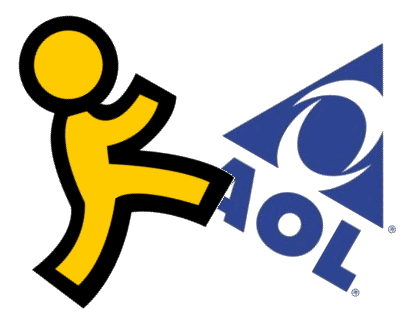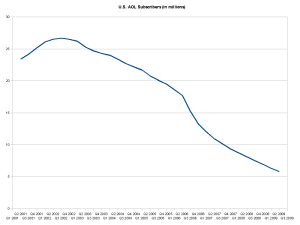Ever since the chapters on AOL I posted last month, I’ve gotten a small but steady stream of emails asking what ever happened to AOL.
A few things:
First, I intend to cover AOL again. We’ll definitely devote a chapter just to the AOL/TimeWarner merger since it was really an epochal event.
Second, it’s a testament to how successful AOL was that people still have nostalgia for it. Like we said, it was the introduction to online life for an entire generation, millions and millions of people.
Third, I can understand the confusion. AOL was a household name. It was something everyone knew, and interacted with every day. Remember what we also said in the episode: AOL was so successful at branding itself that it was one of the best known and loved brands in the world at one point.
And then… it was just gone. So, that has to be baffling if you’re not paying attention. How could something so successful, so fundamental in every day American life just… disappear?
Is America Online Still Around?
Yes.
Or, to be strictly correct, AOL is still around. Not America Online anymore, but AOL, Inc. Obviously, a simple Google search will tell you that, but the details and the story are a bit complicated, so, to satisfy people’s curiosity, here’s the story:
AOL merged with Time Warner for $164 billion in 2000. As I say, this is a fascinating saga, perhaps the most disastrous business merger of all time. So, you’ll have to wait for the episode to get into all this.
Long story short, the merger quickly
went south
. What happened? Quite simply, AOL was on the wrong side of technology history. Dialup was replaced by broadband internet access, largely delivered by cable companies. Despite efforts by AOL to get into the broadband game, they never really did, and as the chart on the right shows, they steadily bled subscribers. In January of 2003, AOL/Time Warner reported a $45 billion dollar writedown to reflect the “declining value of its flagship America Online property.” This led to a $100 billion dollar yearly loss, then the largest in corporate history.
Whereas, at the beginning of the merger, AOL executives had dreamed that they were taking over TimeWarner, most of the AOL executives were eventually ousted from power, and on April 3, 2006, the full name “America Online” was retired. The official name of the service became “AOL”, a mere subdivision of the company once called AOL Time Warner, but now just called Time Warner.
In 2006, the crown jewels, AOL mail and Instant Messenger, the things that made AOL AOL, were transitioned to the web and given away for free.
Shockingly, for all this, AOL did not drop below 10 million subscribers until 2007-2008. Think back to our episodes and how hard AOL had worked to reach 1 million, 2 million users. But to put this in context another way, the iPhone was released in 2007, ushering in the modern internet era. And yet, at that point, AOL still had more internet subscribers than Comcast!
On February 6, 2008, Time Warner announced that it would split AOL’s internet access and advertising businesses in two. On May 28, 2008, Time Warner announced it would spin off AOL as an independent company. It has operated as such ever since.
As an independent company, AOL still has a shockingly large business. It owns Advertising.com, serving as one of the web’s largest advertising networks. And there are plenty of other products AOL is still responsible for. AOL owns major content sites such as the Huffington Post, Moviefone, Engadget, TechCrunch, gdgt, and Stylelist. And AOL made a hugely expensive, and ultimately unsuccessful attempt at creating a local news/community product called Patch, to the tune of hundreds of millions of dollars lost.
AOL Dialup Lives On!
AOL can afford to do things like this because AOL dialup lives on as a service, and is, in fact, still a cash cow. As recently as 2013, two and a half million people were still paying monthly for AOL dialup service. That means that good old AOL dialup was still generating $624 million in revenue a year. There’s something of a reasonable argument for these dialup holdouts. Rural customers sometimes don’t have access to broadband. Older users seem to be happy with what they are used to. And some people just don’t care to pay more. Dialup speeds are fine.
So AOL keeps churning along. In 2013, AOL reported its fourth quarter revenue of $599.5 million, its first growth in quarterly revenue in 8 years. As recently as May, AOL could still report quarterly revenue of $583.3 million and net income of $9.3 million.
So, if you can find an AOL disc, you can still live the old nostalgia if you really want to. And as people have pointed out, for a lot of folks, your AOL screen name tends to live on.














Yes, I was surprised that my AOL account was still active when I hadn’t logged on in years. On April 8 as support for Windows XP was winding down, I wanted to get one last update on the old Toshiba laptop I bought from Best Buy back on Black Friday 2005. I was also uninstalling all the bloatware and cleaning up the desktop when I saw the AOL icon and fired it up to see if I could still log on and voila! Of course virtually everything there is now web based so AOL is really of no use for me except for maybe Rabbitjack’s Casino which I am surprised to see it’s still running.
Always respect those who came before you, and those who were pioneers
Aol sucked. I tried dropping them several times and they kept charging my account anyway! Their customer service would give me shit about how their was activity on the account and crap. I am glad they are no longer the giants of the industry.
I liked AOL, because it was set up with logic and not for sales or celebrity status. Now I cannot log on and I just cry and get more lonely, glad I lived through WWII, but now it seems worthless time is here. Roz
I enjoyed AOL for their Geneaology Programs and find several printed out pages which had some info. I have not found. How would I get back that AOL??? Lynn
Why did it change to AOL shield????
AOL Started it all. The internet was nothing without AOL to start it. It gave us the first access to AIM, Chat rooms, etc. Not to mention it was so simple to use… You’ve got mail! I miss it’s simplicity, and a time when things were more simple.
[…] over time, AOL lost its dominance of the internet as new competitors like Google swamped the […]
I’ll see your AOL, and raise you a Netscape. I still have an active netscape.net email address that I access through… AOL Mail. Netscape for all of you young-uns, was THE browser before the overlords at Microsoft went all Darth Vader with computer manufacturers. Netscape worked better than IE, much like Wordperfect was at least the equal of Word, if not better. So much for the forlorn rememberances of an old (59) codger…